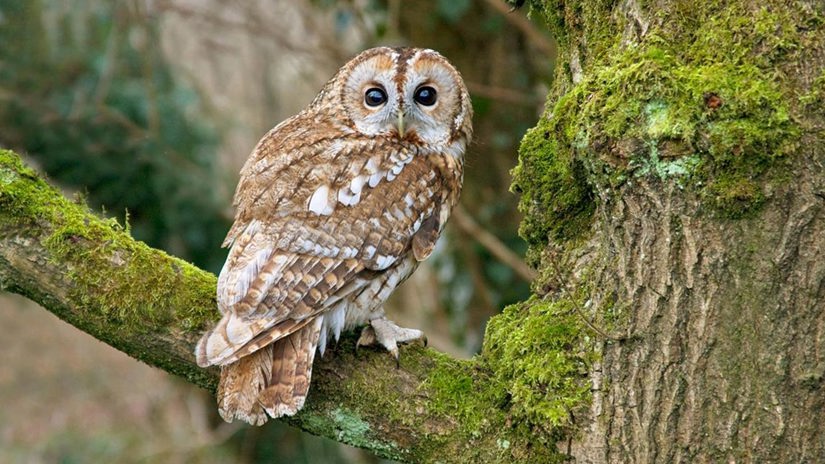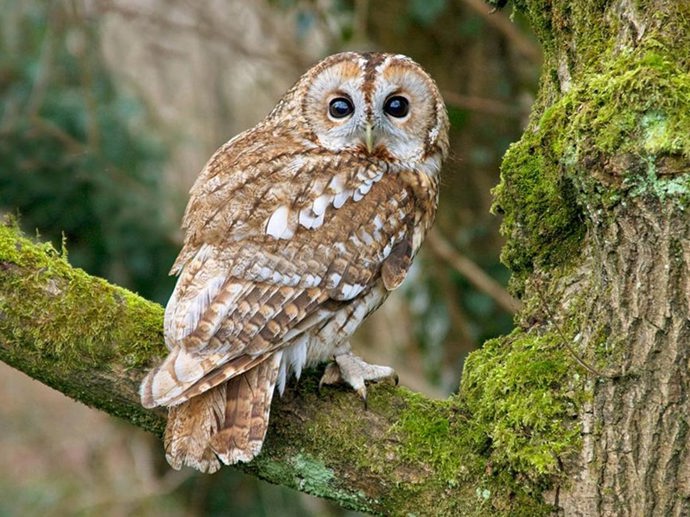Common name: long-eared owl
Scientific name: Asio otus
Family: Strigidae (owls)
Habitat: coniferous or mixed woodland
Diet: voles, mice, small birds
Predators: no natural predators
Origin: native
Wise and regal, with an imposing stare and elusive nature. Our most nocturnal owl, with a penchant for recycling other bird’s old nests. It lives in dense woodland and is a skilful hunter.
Common name: long-eared owl
Scientific name: Asio otus
Family: Strigidae (owls)
Habitat: coniferous or mixed woodland
Diet: voles, mice, small birds
Predators: no natural predators
Origin: native
The long-eared owl has mottled orange-brown feathers, distinct white eyebrows and striking orange eyes. It has large head feathers or ‘ear tufts’ which become raised when the owl is alarmed; normally the tufts are flattened.
It is medium in size, with a wingspan of 95cm. It looks deceptively long and thin when in flight, but is actually no bigger than a woodpigeon.
Not to be confused with: the short-eared owl. When the long-eared owl's head feathers are flattened, it can be confused with the short-eared owl. However, the short-eared has yellow eyes and is paler in colour.

Credit: John Bridges / WTML
The long-eared owl enjoys a diet made up of small mammals, particularly voles and mice. During the winter when food is scarce, it has been known to eat small birds. When hunting, it sweeps through open country, flying to and fro in a zig-zag pattern while scanning the ground for food. Once its prey has been spotted, the owl swoops down and bites the back of the prey's head, immobilising it instantly.
In winter, long-eared owls often roost in a group, which is known as a ‘parliament of owls’.
The long-eared owl is extremely elusive during the breeding season, which takes place from February onwards. It will nest in conifer trees, often rearing its young in the disused nests of other birds. It is also known to use tree hollows and artificial nesting baskets.
It lays a clutch of three to five eggs, and after around 25–30 days the chicks will hatch. The chicks are then ready to fledge 30 days after hatching, although they will still need to be fed by their parents for up to two months.

Credit: David Kjaer / naturepl.com
Long-eared owls live in mixed and coniferous woodland, preferring the cover of dense, shrubby thickets, hedgerows and conifer trees. They are found across the UK, although there are fewer birds in Wales and the South West.

Despite being called the ‘long-eared’ owl, the tufts on its head aren’t actually ears at all; they are simply used to make it look bigger!
The best time to spot long-eared owls is when they are on migration, travelling to coastal areas, or when they are travelling to or from roosting sites during the winter. As they are nocturnal – and said to be the most nocturnal of all the owls – and hunt at night, this would be the best time to see them on the wing. Listen out for their sombre ‘hoo, hoo’ hoot during summer evenings.

Credit: Paul Johnson / Alamy Stock Photo
The long-eared owl is believed to be abundant in the UK; however it is difficult to determine exact populations due to the bird’s elusive nature. It has been suggested that long-eared owls are declining in some areas due to habitat loss and an increase in competition with the tawny owl.
There is thought to be a larger population of long-eared owls in Ireland, which could be because the tawny owl (the long-eared owl’s biggest competitor) is not present there.


Charlotte Varela • 21 Dec 2023
Heard a screech in the night or a hoot in the woods? One of the UK's five resident owl species could be at large. Learn how to identify owl calls, from tawny owl to barn owl.